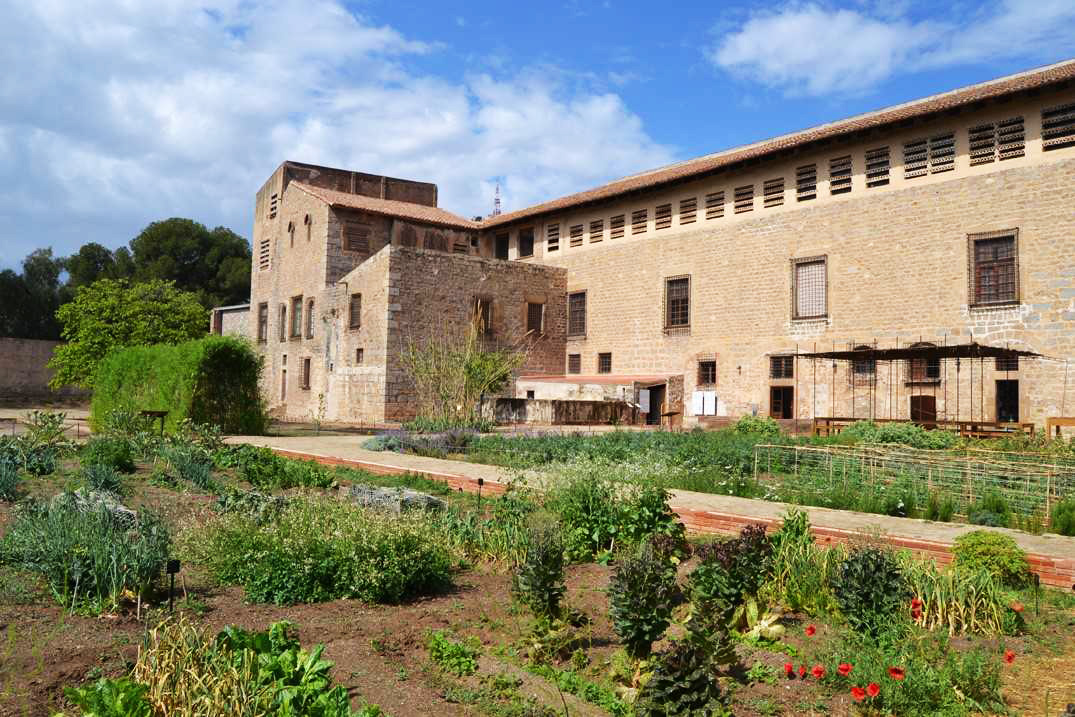
Main Menu Layer
The medieval vegetable garden
Posició PDF Visualitzat
L'Hort Petit del Monestir, as referred to by the nuns (the monastery’s little vegetable garden, in English), is a walled compound of almost 3,000 square metres located on the southern face of the structure, opposite the Sala de les Procures, where the harvest was once stored. This not-so-little vegetable garden was used by the nuns to grow some of the vegetables, greens, legumes and fruit that they cooked, and also the herbs used to prepare medicinal products for the community from the convent’s very foundation in 1327 up until the end of the 20th century.
In 2017, the Monastery Museum launched a project to recover the original use of this space, with a view to rebuilding a vegetable garden consisting of four plots, just as it would have looked like in the Middle Ages. Therefore, it doesn’t include the species that were imported from the Americas to Europe from 1492 onwards. To really discover what the medieval vegetable garden would have looked like, a multidisciplinary team was set up consisting of specialists from the fields of history, archaeology, botanical sciences, archaeobiology, architecture, museum sciences, environmental education and social services, who have approached the project from different perspectives.
The archaeological study performed at the start of the project made it possible to document five clear chronological phases of the space’s use, ranging from the 14th century to the 19th century. Thanks to this study of the vegetable garden’s subsoil, it was possible to recover historic paths and traditional irrigation facilities. The space and the different museographical elements have been defined on the basis of this knowledge, such as the distribution of the plots, ensuring the coexistence of the green space, the architectural structure and the history of the monastery and its museum.
The restoration of the vegetable garden from a historic perspective has entailed an exhaustive study with a view to determining the species to be planted. To this end, medieval documents kept in the monastery’s archives were consulted, in addition to agricultural treaties from the time when the crops were harvested and the cultivation techniques used during the Middle Ages.

The vegetable garden, which will be open to visitors from 1 June 2022, includes native and local species that are currently not grown or are in danger of extinction. The first two plots will be worked on during the first phase of the project.
The first plot, measuring 283 square metres, is dedicated to vegetables. Greens such as spinach and lettuce have been planted here, which boast a high vitamin content and must be consumed tender. The produce need almost daily care, in addition to lots of light and water. They have been planted along the sides of the ridges and the irrigation water circulates through the grooves. In the second year, the produce from this plot will be transferred to the second plot.
The second plot, measuring 290 square metres, is dedicated to extensive agriculture with legumes such as peas, lentils and chick peas. Growing legumes is highly beneficial to the soil, as they help to regenerate it. These can be consumed tender, but can also be stored dry. This means that it is possible to stock up on this produce, which offers high levels of vitamins and proteins. In the second year, this produce will be planted in the first plot.
At the Hort Petit, medieval agricultural techniques are used, which coincidentally are organic. This type of agriculture is one of the cornerstones of what is now known as ecological farming, which is complemented by modern scientific and technological knowledge. The aim of medieval and organic techniques is to avoid the misuse of natural resources and avoid compromising the needs of future generations. To combat plagues and ensure the fertility of the soil, techniques such as polyculture, alternation and crop combination, the use of organic nutrients and fertilisers, the selection of local species adapted to the local climate conditions and the effective use of irrigation are employed. Everything that is used in the vegetable garden is from the vegetable garden itself, and everything is organic and renewable.
The opening of this new space at the museum will help to promote positive values and attitudes with regards to caring for the environment and invigorating culture through cooperative and inclusive work. It is a project that offers a new interpretation of the monastery’s environment as part of a dialogue between historic and natural heritage, setting the scene for a series of educational and social projects in the surrounding area. In this connection, as part of the vegetable garden's management, local institutions who work to include groups at risk of social exclusion are involved. Through Learning Service school projects, these institutions responsible for maintaining the vegetable garden will get in contact with students from local schools to set up a network that promotes the development and transformation of the community, the promotion of values such as caring for the environment, local consumption and equity between all members of society.
In 2024, the medieval garden of the Royal Monastery of Santa Maria de Pedralbes, has been recognized as one of the 10 best practices in cultural heritage in Europe by the European Heritage Hub, a pilot project funded by the European Union born to promote the transition towards a sustainable, digital, and inclusive society.









